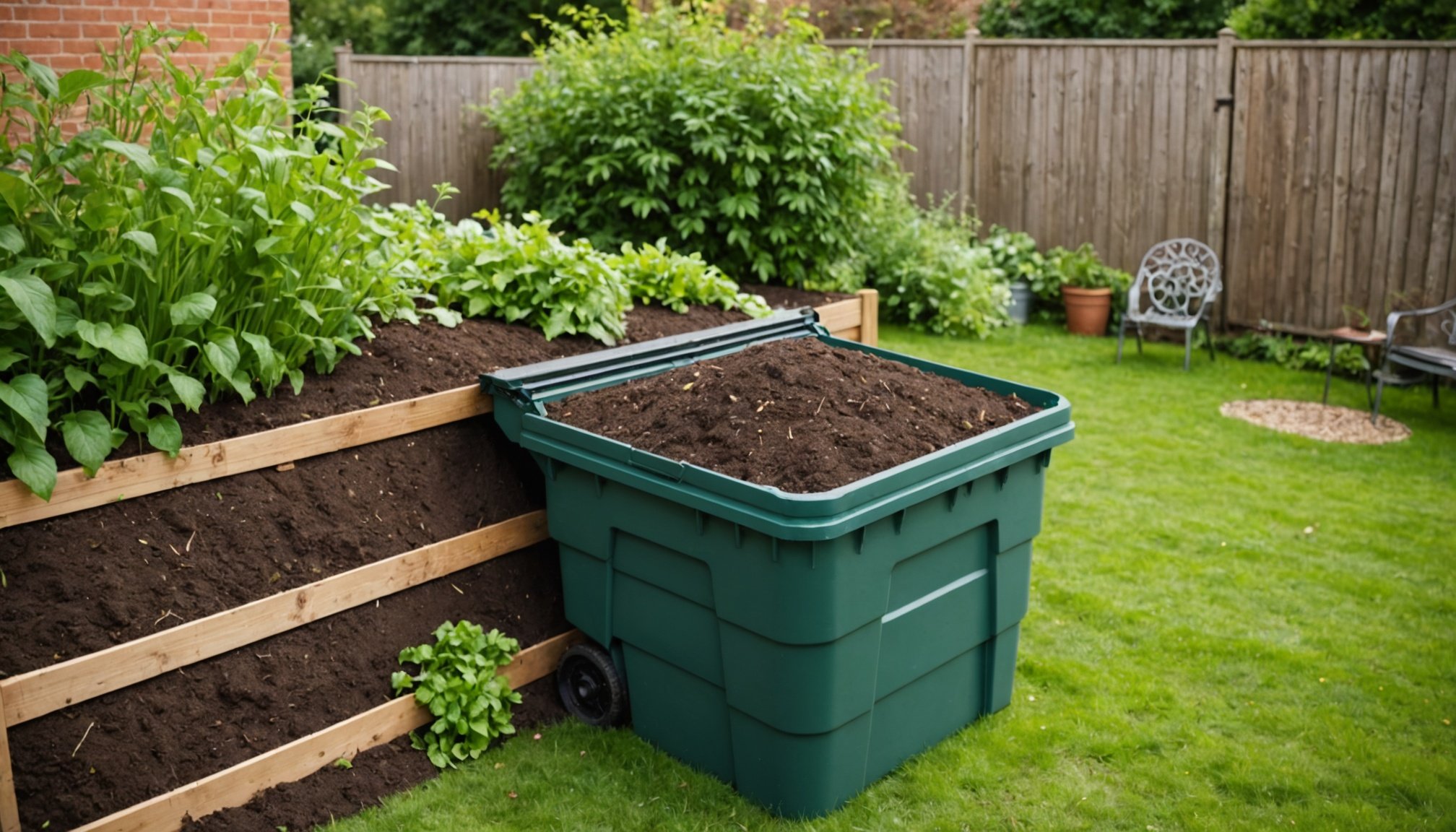Creating a backyard composting system can significantly reduce household waste while enriching your garden. This ultimate guide empowers UK homeowners with practical strategies to design an efficient composting setup tailored to local conditions. Learn how to select the right materials, manage the process, and troubleshoot common challenges. By embracing composting, you not only contribute to sustainability but also transform kitchen scraps into valuable nutrients for your plants, fostering a healthier environment. Get ready to cultivate a greener lifestyle with simple, effective practices!
Understanding Composting Basics
Composting is an eco-friendly process that transforms organic waste into nutrient-rich soil, playing a crucial role in sustainable gardening and waste reduction. At its core, composting involves the natural decomposition of organic materials such as food scraps, leaves, and grass clippings. This process is driven by microorganisms like bacteria and fungi, which break down the materials into simpler compounds.
Sujet a lire : Ultimate Guide to Safeguarding Electrical Outlets for Kids in Your UK Home
The Science Behind Composting
The science of composting hinges on the balance of carbon and nitrogen, often referred to as the "brown" and "green" materials, respectively. Carbon-rich materials include dried leaves and straw, while nitrogen-rich materials encompass kitchen scraps and fresh grass clippings. Maintaining a proper ratio of these materials is vital for efficient decomposition. Additionally, oxygen and moisture are essential components, as they enable the microorganisms to thrive and accelerate the breakdown process.
Types of Composting Systems
There are several composting systems to consider, each catering to different needs and environments:
A voir aussi : Step-by-Step Guide to Installing a Greywater System for Eco-Friendly Garden Irrigation in the UK
- Aerobic Composting: Utilises oxygen and requires regular turning to maintain airflow.
- Anaerobic Composting: Functions without oxygen, often producing a strong odour.
- Vermicomposting: Involves earthworms to speed up decomposition, ideal for indoor settings.
Choosing the right system depends on factors such as available space, time commitment, and personal preference. Understanding these composting fundamentals will help you make informed decisions for effective waste management and soil enrichment.
Benefits of Backyard Composting
Backyard composting offers numerous advantages that extend beyond simple waste management. One of the primary benefits is its positive impact on the environment. By composting organic waste, individuals can significantly reduce the amount of waste sent to landfills, thereby decreasing methane emissions—a potent greenhouse gas. This practice contributes to a more sustainable ecosystem by recycling nutrients back into the soil.
Economically, composting can lead to savings for households. By producing your own compost, you reduce the need to purchase commercial fertilizers and soil conditioners. This not only cuts costs but also ensures that your garden benefits from chemical-free, nutrient-rich compost, promoting healthier plant growth.
Moreover, composting enhances soil quality and plant health. The process enriches the soil with essential nutrients, improving its structure and moisture retention. This leads to vigorous plant growth and increased resistance to pests and diseases. The improved soil quality is especially beneficial for home gardens, as it supports a thriving biodiversity that further aids in maintaining a balanced ecosystem.
In summary, the advantages of composting include environmental conservation, economic savings, and improved soil and plant health, making it a valuable practice for any eco-conscious gardener.
Materials Needed for Composting
When setting up a successful compost pile, understanding the essential materials is crucial. The effectiveness of composting hinges on the balance between "green" and "brown" materials. Green materials, rich in nitrogen, include items like kitchen scraps, fresh grass clippings, and coffee grounds. These provide the necessary proteins and enzymes that fuel microbial activity. In contrast, brown materials, which are carbon-rich, consist of dried leaves, straw, and wood chips. They offer the energy source required for decomposition.
Green vs. Brown Materials
The interplay between green and brown materials is vital. A balanced compost pile typically requires a ratio of about 2:1 of browns to greens. This ensures optimal microbial activity and prevents unpleasant odours. The browns help aerate the pile, while the greens maintain moisture and nutrient levels.
Items to Avoid in Composting
Certain items should be avoided in composting to ensure the health of the pile. These include:
- Meat and dairy products, as they attract pests and create odours.
- Diseased plants, which may spread pathogens.
- Chemically treated wood, which can introduce toxins.
By selecting the right composting materials and avoiding problematic items, you can create a thriving compost pile that contributes to a sustainable garden environment.
Step-by-Step Guide to Setting Up a Composting System
Setting up a composting system is a straightforward process that begins with selecting the right location. Choose a spot that is easily accessible, has good drainage, and receives partial sunlight. This ensures that your compost pile maintains the right temperature and moisture levels.
Building or Purchasing a Compost Bin
Next, decide whether to build or purchase a compost bin. A compost bin helps contain the materials and maintain an ideal environment for decomposition. If you opt to build one, use materials like wood or wire mesh. Alternatively, commercial bins are available in various sizes and designs to suit different needs.
Layering Materials Correctly
The key to a successful composting setup is layering materials correctly. Start with a base layer of coarse materials like twigs or straw to promote airflow. Follow this with alternating layers of "green" and "brown" materials. Maintain a ratio of about 2:1 browns to greens to ensure efficient decomposition. Water each layer lightly to maintain moisture.
By carefully selecting the location, choosing the right bin, and layering materials properly, you can establish an effective composting system that supports sustainable gardening practices.
Maintaining Your Compost Pile
Proper compost maintenance is key to achieving a thriving compost system. Regularly turning and aerating your compost pile ensures that oxygen reaches the microorganisms responsible for decomposition. This process accelerates breakdown and prevents unpleasant odours. Aim to turn your pile every one to two weeks using a pitchfork or compost aerator to mix the materials thoroughly.
Monitoring moisture levels is another crucial aspect of compost maintenance. Your compost should feel like a damp sponge—moist but not soggy. If the pile is too dry, decomposition slows down; if too wet, it may become anaerobic, leading to foul smells. Adjust moisture by adding water or dry materials as needed.
Temperature is also an important indicator of compost health. A well-maintained pile should reach temperatures between 55°C and 65°C (131°F to 149°F), which is ideal for breaking down materials and killing pathogens. Use a compost thermometer to check the temperature regularly. If the pile is too cool, add more nitrogen-rich materials or turn it more frequently.
Signs of a healthy compost system include a pleasant earthy smell, a consistent breakdown of materials, and the presence of beneficial organisms like worms and insects. These indicators suggest your compost is on the right track.
Troubleshooting Common Composting Issues
Even the most well-intentioned composters can encounter composting problems. Understanding how to identify and resolve these issues ensures a healthy compost system.
Identifying and Resolving Odor Issues
A common problem is unpleasant odours, often caused by an imbalance of materials. Odor issues typically arise when there's too much nitrogen-rich material or insufficient aeration. To fix this, incorporate more carbon-rich "browns" like dried leaves and ensure regular turning to introduce oxygen.
Addressing Pests and Vermin in Compost
Compost piles can attract pests and vermin if not managed properly. Meat, dairy, and oily foods can lure unwanted visitors. To prevent this, avoid these items and cover food scraps with a layer of browns. If pests persist, consider using a closed compost bin or adding wire mesh to deter access.
Fixing Slow Decomposition Problems
Slow decomposition can be frustrating, often resulting from incorrect moisture levels or an improper carbon-to-nitrogen ratio. Ensure the compost is moist, akin to a damp sponge, and adjust the balance by adding greens or browns as needed. Regularly turning the pile also accelerates the process by maintaining oxygen flow and distributing heat evenly.
Optimizing Compost Quality
Enhancing the nutrient content of your compost is essential for maximizing its benefits for soil and plants. One effective technique is to diversify the materials you add. Including a wide range of green and brown materials ensures a balanced nutrient profile. For instance, adding vegetable peels, coffee grounds, and grass clippings can boost nitrogen levels, while shredded newspaper and dried leaves increase carbon content.
The Role of Additives in Composting
Additives can play a significant role in improving compost quality. Introducing materials like bone meal or rock phosphate can enrich phosphorus levels, essential for root development. Additionally, adding lime can help neutralize acidity, creating a more hospitable environment for microorganisms. However, it's important to use additives sparingly to avoid disrupting the natural balance of your compost pile.
Testing Compost for Readiness
Testing your compost for readiness ensures it is fully decomposed and ready to use. A simple way to check is by observing its appearance and smell. Mature compost should be dark, crumbly, and have an earthy odour. For a more precise assessment, consider using a home compost test kit to measure pH levels and nutrient content. This will help you determine if your compost is optimally prepared for enriching your garden soil.
UK Regulations and Guidelines for Composting
Composting in the UK is governed by a set of regulations designed to ensure environmental safety and public health. The key regulatory framework is the Environmental Permitting Regulations, which dictate how composting sites should operate. These regulations require permits for larger-scale operations, while smaller domestic composting is generally exempt. It's essential for composters to understand these guidelines to maintain compliance and promote sustainable practices.
Local Authorities and Community Composting Initiatives
Local authorities play a significant role in supporting composting efforts. Many councils offer guidance and resources to encourage community composting initiatives. These programs often provide compost bins and educational workshops to help residents engage in responsible composting. By participating in these initiatives, communities can collectively reduce waste and enhance local soil quality.
Best Practices for Compliance and Safety
To comply with UK composting regulations, it's crucial to adhere to best practices. This includes ensuring that compost piles are well-managed to prevent odours and pests. Regular monitoring of temperature and moisture levels is recommended to maintain optimal conditions. Additionally, composters should avoid adding prohibited materials, such as meat and dairy, to prevent attracting vermin. By following these guidelines, individuals can contribute to a safe and effective composting environment.
Composting Adaptations for UK Conditions
Composting in the UK requires unique adaptations due to its distinct climate and waste types. Understanding these factors can enhance composting efficiency and success.
Climate Considerations for Composting in the UK
The UK's temperate climate, with its cool and wet conditions, influences composting practices. Maintaining the right balance of moisture is crucial; too much rain can make compost soggy, slowing decomposition. To counteract this, cover compost piles during heavy rainfall and ensure adequate drainage. Conversely, during dry spells, regularly check moisture levels and add water if needed to keep the compost like a damp sponge.
Managing Seasonal Variations in Compost Materials
Seasonal changes affect the availability and type of compost materials. In autumn, there is an abundance of carbon-rich leaves, ideal for balancing nitrogen-heavy materials like grass clippings available in spring and summer. During winter, composting slows due to lower temperatures. Consider insulating your compost bin with straw or cardboard to retain heat and encourage microbial activity.
Local Waste Types and Their Composting Needs
The UK generates specific waste types that require tailored composting approaches. Garden waste, kitchen scraps, and even tea bags are commonly composted. Be mindful of local council guidelines on waste collection and composting to ensure compliance and maximise the benefits of your composting efforts.
Frequently Asked Questions about Composting
Composting can seem daunting, but addressing common misconceptions helps clarify the process. One prevalent myth is that composting always produces unpleasant odours. In reality, a well-maintained compost pile should emit a pleasant, earthy smell. This is achieved by maintaining the right balance of carbon and nitrogen-rich materials and ensuring adequate aeration.
Another misconception is that composting requires a large amount of space. However, there are various systems, including vermicomposting, suitable for small spaces like apartments. These systems efficiently break down organic waste without taking up much room.
Resources for Further Composting Education
For those eager to delve deeper into composting, numerous resources are available. Many local councils offer workshops and online courses to educate residents about effective composting techniques. Additionally, books and online forums provide valuable insights and tips for beginners and experienced composters alike.
Community Support for Composting Initiatives
Community support plays a crucial role in promoting composting. Many neighbourhoods have established community composting sites where residents can contribute their organic waste. These initiatives not only reduce waste but also foster a sense of community and shared responsibility for the environment. Engaging with local composting groups can provide support and encouragement for those new to the practice.












